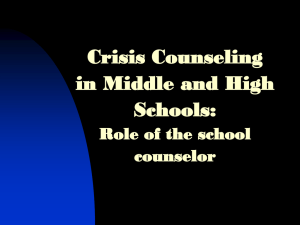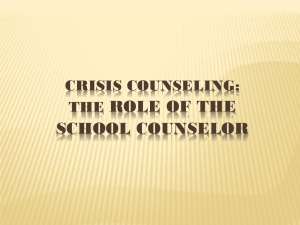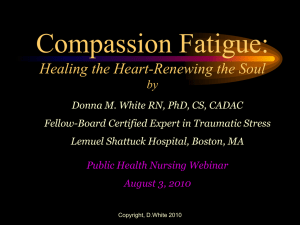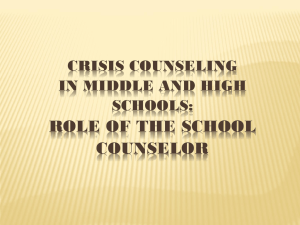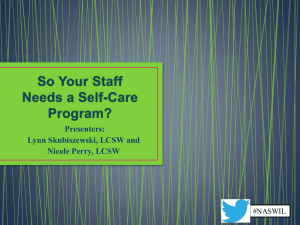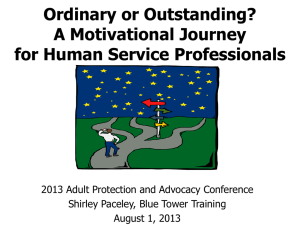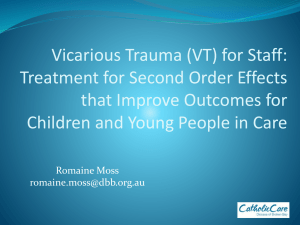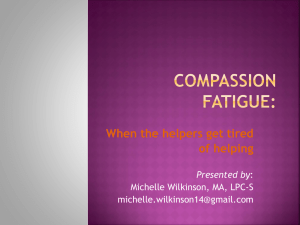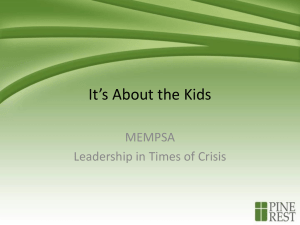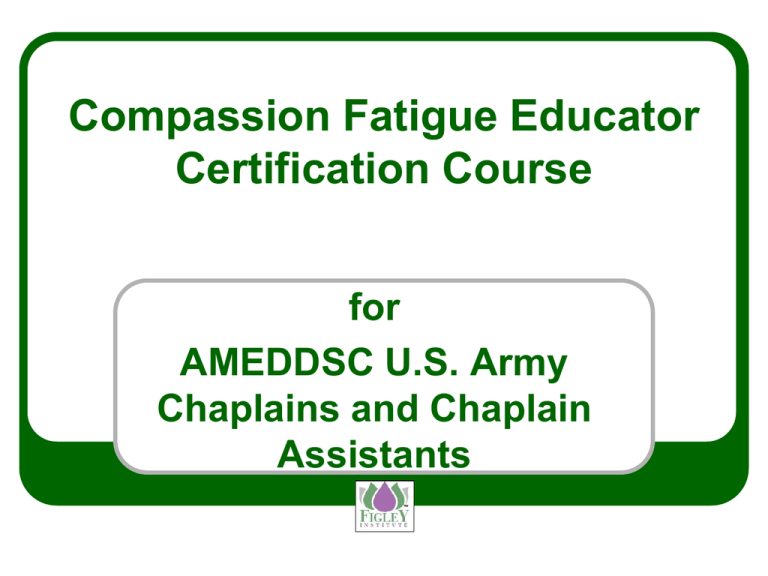
Compassion Fatigue Educator
Certification Course
for
AMEDDSC U.S. Army
Chaplains and Chaplain
Assistants
Presented
2013 September 12 – 08000-01400
Ft. Sam Houston
San Antonio, Texas
by
Dr. Kathleen (Kathy) Regan Figley
President & Founder
Figley Institute
Dedication
To our friend and colleague
Photo by Charles R. Figley
Lt. Col. David E. Cabrera,
Clinical Social Worker,
Uniformed Services University;
Attached to 528th Brigade U.S. Forces – Afghanistan.
Killed in action October 29, 2011,
Kabul, Afghanistan.
(c) Figley Institute 2013
Acknowledgements
Thanks to
CH (LTC) Charles (Chuck) B. Rizer JR.
Training Manager, Chaplain
AMEDD Center and School
Fort Sam Houston, Texas
(c) Figley Institute 2013
Gratitude
Thank you
for your service to
wounded warriors
and
those who love them.
(c) Figley Institute 2013
Introduction
Part I
(p. 1)
Agenda
Participant Guide Overview
Time
Section
Topic
0800
Part I
Introduction
Part II
Definitions
Part III
Getting Started – Standards of Self-Care
Part IV
Committing to Self-Care
Part V
Taking the Inventories – A Baseline for Self-Care
Planning
Part VI
Taking Action! Implementing a Self-Care Plan
1400
(c) Figley Institute 2013
Daily Wrap-Up
Course Goal (p. 1)
To provide each participant with the
knowledge and skills necessary to reduce
the secondary impact of working with
traumatized populations.
(c) Figley Institute 2013
A quick (humorous) stress test…
Video –
skateboarder observed incident
With whom do you identify?
Driver? Pedestrian? Skateboarders?
(c) Figley Institute 2013
Course Objectives (p. 1)
Upon completion of the one day training,
participants will be able to
1.
Articulate the developmental history of
compassion fatigue including
countertransference, caregiver stress,
burnout, vicarious traumatization, and
secondary traumatic stress
(c) Figley Institute 2013
2.
Differentiate between compassion
fatigue, secondary traumatic stress, and
vicarious traumatization;
3.
Articulate the unique array of symptoms
indigenous to compassion fatigue;
(c) Figley Institute 2013
4.
5.
6.
Assess and identify symptoms of
compassion fatigue in self and others;
Recognize compassion fatigue triggers
and early warning signs;
Articulate current theoretical models for
the etiology and transmission of
compassion fatigue;
(c) Figley Institute 2013
7.
Articulate and teach others the potential
effects of traumatic stress upon
systems (marriage, family, workplace,
etc);
8.
Identify and utilize resources and plans
for resiliency and prevention for self and
ability to facilitate this plan with others;
(c) Figley Institute 2013
9.
Create and maintain a self-care plan for
self and others and familiar with the
Academy of Traumatology’s Standards of
Self Care for traumatologists.
10.
Facilitate a self-care plan for self and
others;
(c) Figley Institute 2013
11.
Provide psycho-education on the
causes, symptoms, prevention, and
treatment of compassion fatigue; and
12.
Abide by the Academy of Traumatology
Standards of Practice.
(c) Figley Institute 2013
Getting to Know You
1.
2.
3.
4.
5.
6.
Work in table groups
Identify volunteer to serve as group
spokesperson
Spokesperson list names and duty stations of
those in group on index card
Identify three major areas of work related
challenges
Report out names and challenges
Turn card in to me
(c) Figley Institute 2013
A bit about me Education
Education
•
•
•
•
•
•
BS Psychology (1981)
MS Counseling and Human Systems (1983)
Certified Traumatologist (1997)
Master Traumatologist (1999)
Certified Compassion Fatigue Therapist (2004)
DMin Pastoral Counseling (2008)
(c) Figley Institute 2013
A bit about me - Experience
Field Practitioner
• Human Services and Crisis Counseling
• Crisis Intervention in the workplace
Murder, suicide, armed robbery
Field Instructor, e.g.,
• Clinicians, first responders, emergency
managers, hospital chaplains, and U.S.
military (Army and Navy)
(c) Figley Institute 2013
Agenda
Time
Section
Topic
0800
Part I
Introduction
Part II
Definitions
Part III
Getting Started – Standards of Self-Care
Part IV
Committing to Self-Care
Part V
Taking the Inventories – A Baseline for Self-Care
Planning
Part VI
Taking Action! Implementing a Self-Care Plan
1400
(c) Figley Institute 2012
Adjourn
Definitions
Part II
(p. 2)
Objectives 1, 2, 7
Video: When Helping Hurts
Available from GiftFromWithin.org*
• Short version 17 minutes
• Long version 52 minutes
• Short clips (1 – 3 minutes) available for free
at the website
*Figley Institute does not receive compensation for video sales.
(c) Figley Institute 2013
Primary Stress Injuries (p. 2)
Acute Stress
Acute Stress Disorder
Posttraumatic Stress Disorder
(c) Figley Institute 2013
Secondary Stress Injuries (p. 4)
Compassion Fatigue
Secondary Traumatic Stress
Vicarious Trauma
(c) Figley Institute 2013
Burnout (p. 5)
Exhaustion mixed with anxiety and
depression
Negative self-esteem
Poor attitude
Reduced efficiency
Reduced effectiveness
(c) Figley Institute 2013
Shared Trauma (p. 5)
Affective, behavioral, cognitive, spiritual
and multi-modal responses as a result of
primary and secondary exposure to the
same collective trauma as their clients.
(c) Figley Institute 2013
Resilience (p. 6)
Ability to physiologically and
psychologically adapt to environmental
changes
Characteristic of survivors (rather than
victims)
(c) Figley Institute 2013
Post-Traumatic Growth (p. 6)
Positive changes which result from
struggling to cope with a traumatic event.
(c) Figley Institute 2013
Getting Started –
Standards of Self Care
Part III
(p. 7)
Objectives 3, 5, 6 7, 11
Create Case Study (15 minutes)
Working in groups of 4, develop a case study profile
• Preferable that group members are of same or similar
rank
Record information (see next slide)
Create 2 index cards
1 for your table group and 1 for me
with the same information on both cards.
Select group spokesperson who will have 2-3
minutes to report out.
(c) Figley Institute 2013
Report Out (Present)
In 2-3 minutes, provide the following information.
1.
2.
3.
The names and duty stations of those in your
group.
Case study demographics and current status
• Name, age, sex, marital status, discipline
• Current assignment; length in current assignment
• Average “caseload” seen/week
• Perceived level of work performance
• Caregiver Reactions (Table 1, p. 38)
• Healthy Coping (Table 2, p. 39)
Turn in extra index card to me when done
(c) Figley Institute 2013
Case Study:
Chaplain Pat
Due to high
Compassion
Fatigue Score,
Pat also took
the Secondary
Traumatic
Stress Scale.
Results indicate
need for further
assessment by
a professional.
Blue
Very Good Health
Green
Health
Yellow
At Risk for Injury
Orange
High Injury
Red
Very High Injury
SoSC-I. Purpose of Guidelines (p. 7)
Do no harm to self in line of duty.
Attend to needs
Physical
Social
Emotional
Spiritual
(c) Figley Institute 2013
Model of Compassion Stress and
Fatigue (p. 44)
(c) Figley Institute 2013
SoSC-II. Ethical Principles (p. 7)
Do no harm!
Compassion Fatigue has been linked to
ethical errors therefore
It is unethical to neglect self care
(c) Figley Institute 2013
SoSC-III. Humane Practice of
Self Care (p. 7)
Wellness
Physical rest and nourishment
Emotional rest and nourishment
Sustenance modulation
(c) Figley Institute 2013
SoSC-IV. Appreciation and
Compensation (p. 7)
Increased satisfaction sustains workers
emotionally and spiritually
• In what ways does the Army meet needs for
recognition and compensation?
Select one or more advocates
• “accountability buddy”
(c) Figley Institute 2013
Committing to Self Care
Part IV
(p. 8)
Objectives 6, 8
SoSC-V. Establishing and
Maintaining Wellness (p. 8)
Commitment to self care
Strategies for letting go of work
Strategies for gaining a sense of
achievement
(c) Figley Institute 2013
Caregiver Resilience Model
(p. 45)
Introduction to the Caregiver Resilience Model
Caregiver
(Genetic & Innate)
Protective
Factors
Additional
Protective
Factors
Stressors:
Personal Life
Work
Environment
September 2008
(c) Figley Institute 2013
Caregiver
Reactions
C
a
r
e
g
i
v
e
r
Caregiver
Health
C
a
r
e
Caregiver
Injury
© Figley & Figley 2008
5
Attitude is everything
Run time 3:16
Options
• Watch the clip or
• Close eyes and enjoy the music or
• Relax for three minutes
(c) Figley Institute 2013
Taking the Inventories –
A Baseline for elf-Care
Planning
Part V
(p. 8)
Objectives 3, 4, 5, 7, 8, 9,10
SoSC-VI. Inventory of Self-Care
Practice – Personal (p. 8)
Physical
Psychological
Social/Interpersonal
(c) Figley Institute 2013
Self-Assessments (SA 1-6) p. 11
1.
2.
3.
4.
5.
6.
Social Readjustment Rating Scale
How Vulnerable are you to Stress?
Ego Resiliency
Self-Compassion
Posttraumatic Growth Inventory
Spiritual Intelligence
(c) Figley Institute 2013
Caregiver Resilience Model
(p. 45)
Introduction to the Caregiver Resilience Model
Caregiver
(Genetic & Innate)
Protective
Factors
Additional
Protective
Factors
Stressors:
Personal Life
Work
Environment
September 2008
(c) Figley Institute 2013
Caregiver
Reactions
C
a
r
e
g
i
v
e
r
Caregiver
Health
C
a
r
e
Caregiver
Injury
© Figley & Figley 2008
5
SoSC-VII. Inventory of Self-Care
Practice - Professional (p. 9)
SA-7 ProQOL
SA-8 Secondary Traumatic Stress Scale
• Compassion Satisfaction
• Compassion Fatigue
• Burnout
• Secondary Traumatic Stress
• Intrusion
• Avoidance
• Arousal
(c) Figley Institute 2013
Activity: Case Study
Each group will complete selfassessments their case study
Minimum:
Social Readjustment Rating Scale
How Vulnerable are you to stress?
Ego Resilience
ProQOL
(c) Figley Institute 2013
Taking Action!
Implementing a
Self-Care Plan
Part VI
(p. 10)
Objectives 9, 10, 11, 12
Chaplain Pat
SRRS = 37% change of developing
minor illness in next two years
Stress vulnerability (state resilience) =
Excellent resistance to stress
Ego resilience = very high trait resilience
(c) Figley Institute 2013
Chaplain Pat (continued)
Self Compassion = moderate (beats self
up sometimes for making mistakes)
Posttraumatic growth = small degree
• Note: Pat had serious incident in past when
transformed spiritually by traumatic event
Spiritual Intelligence= satisfied
• Would like to increase conscious state
expansion
(c) Figley Institute 2013
Chaplain Pat (continued)
ProQOL
Secondary traumatic stress –
• Compassion Satisfaction – high
• Burnout – low
• Compassion Fatigue – high
• Arousal
• Avoidance
• Meets criteria for further evaluation
(c) Figley Institute 2013
I’m FINE!
Freaked out
Insecure
Neurotic
Emotional or
(c) Figley Institute 2013
Emotionally numb
Video
Care for the Caregiver (23 minutes)
(c) Figley Institute 2013
SMART Goals
Specific
Measurable
Attainable
Realistic
Time-Based
(c) Figley Institute 2013
SoSC-VIII. Prevention Plan
Development (p. 10)
Review self-assessments
Develop goals
Analyze resources and obstacles/
resistances
Discuss with Advocate/Accountability
Buddy
Activate plan and monitor at regular
intervals
Celebrate accomplishments
(c) Figley Institute 2013
Strategies for Inducing Relaxation
Response (p. 40)
Strategies for Inducing Relaxation Response
Stress Reaction
Breath Work Meditation
Progressive
Relaxation
Visualization/
Guided
Imagery
Anxiety
X
X
X
X
Chronic pain
X
X
X
X
Depression
Fatigue
Headaches/ Migraine
Headaches
High Blood Pressure
X
X
X
X
X
X
X
X
X
X
X
Insomnia
X
Irritability
X
Muscle Tension
X
(c) Figley Institute 2013
X
X
X
X
X
X
X
Compassion Stress Management
Techniques (Table 4, p. 41)
When working with Clients/Patients
Between Clients/Patients & After Work
(c) Figley Institute 2013
Professional Care
Refer to Table 5, p. 42
(c) Figley Institute 2013
Trauma-Informed Care
http://www.samhsa.gov/nctic/trauma.asp
Trauma-specific interventions are
designed specifically to address the
consequences of trauma in the individual
and to facilitate healing. Treatment
programs generally recognize the
following:
Standards of Practice
p. 49
(c) Figley Institute 2013
The survivor's need to be respected,
informed, connected, and hopeful
regarding their own recovery
(c) Figley Institute 2013
The interrelation between trauma and
symptoms of trauma (e.g., substance
abuse, eating disorders, depression, and
anxiety)
(c) Figley Institute 2013
The need to work in a collaborative way
with survivors, family and friends of the
survivor, and other human services
agencies in a manner that will empower
survivors and consumers
(c) Figley Institute 2013
Trauma-informed organizations,
programs, and services are based on an
understanding of the vulnerabilities or
triggers of trauma survivors that
traditional service delivery approaches
may exacerbate, so that these services
and programs can be more supportive
and avoid re-traumatization.
(c) Figley Institute 2013
Activity: Case Study
Review self-assessments
Develop goals
Analyze resources and obstacles/
resistances (p. 36)
Report out (directions next slide)
• Score Pattern Analysis (p. 34)
• Self-Care Goal Worksheet (p. 36)
(c) Figley Institute 2013
Report Out & Discussion
1.
2.
3.
Describe the case study using the
Caregiver Resilience Model as an
outline
Describe score pattern (you may use
visuals if you like)
Describe self-care goals,
obstacles/resistances, and resources
which may help overcome them.
(c) Figley Institute 2013
Wrap-Up
The Joy of Your Work
by Kathy Regan Figley
The joy of your work
is tarnished by their stories.
Their pain is your pain.
Flashes, images
still with you when you’re sleeping
do not serve you well.
You know what you need
to rejuvenate at depth.
Take care of yourself.
(c) Figley Institute 2013
Thank you for a great day!
Wishing you safe travel and
a good weekend.
(c) Figley Institute 2013
Traumatic Experience (primary and
secondary) can cause us to forget
who we are at the deepest levels
Our relationship to something bigger
than ourselves may be damaged
Our connection to all that nourishes us
within our souls may be ruptured
It is usually at a time of crisis that
counseling may be sought
(c) Figley Institute 2013
To be reminded of our spiritual nature is to
facilitate spiritual connection… then one
can
Make meaning of event
At a spiritual level, the counselor must be
clear in own spiritual life and able to
make meaning of own traumas.
As a mental health professional level, the
counselor must understand the ways in
which exposure to trauma effects the
spiritual life.
(c) Figley Institute 2013
By taking the assessment and
creating a self care plan you have
demonstrated
Courage, compassion and a willingness
to take risk to change the status quo so
that military personnel and caretakers
alike will thrive.
You are the beginning of cultural
change.
THANK YOU!
(c) Figley Institute 2013
Conclusion
Making a commitment to attend to one’s
own self care takes courage.
Supporting others in attending to their
self care and growth takes compassion
To institute a culture that honors and
nourishes its Caregivers involves risk.
(c) Figley Institute 2013

